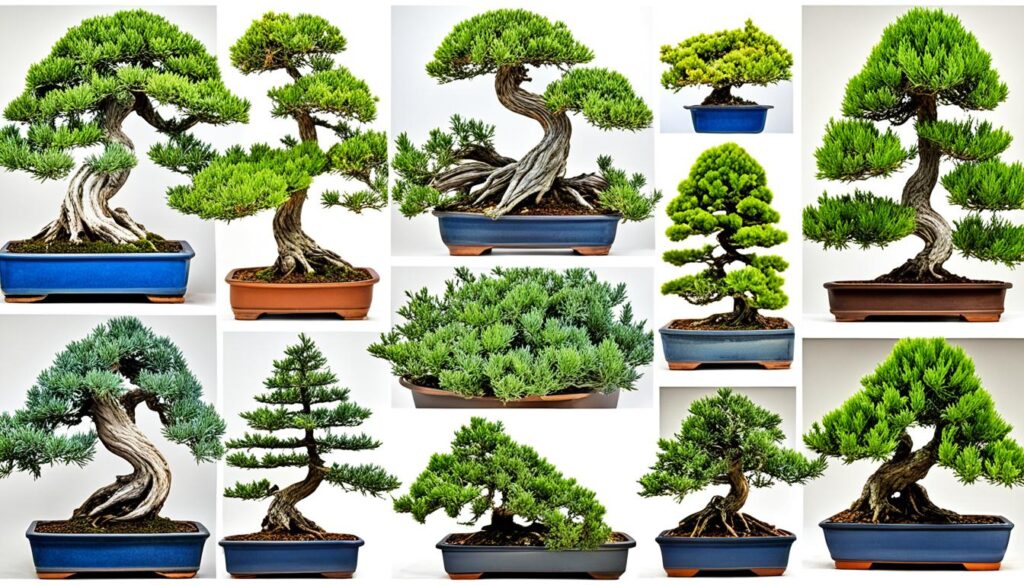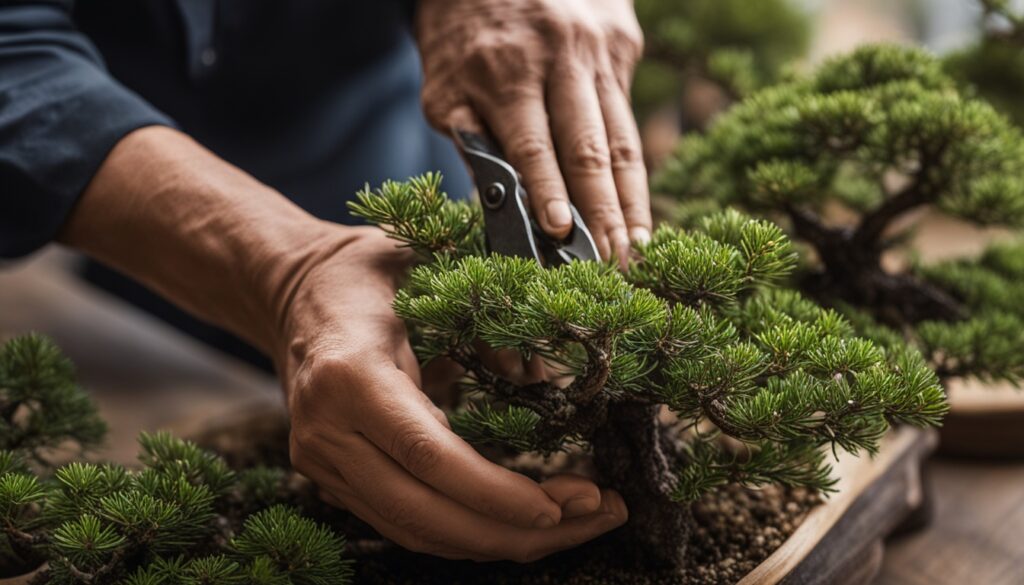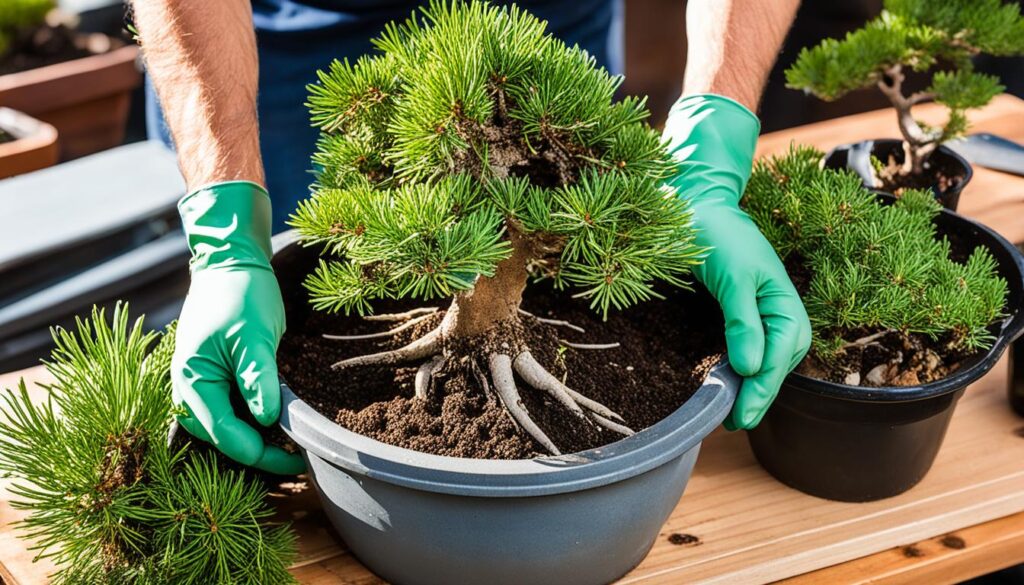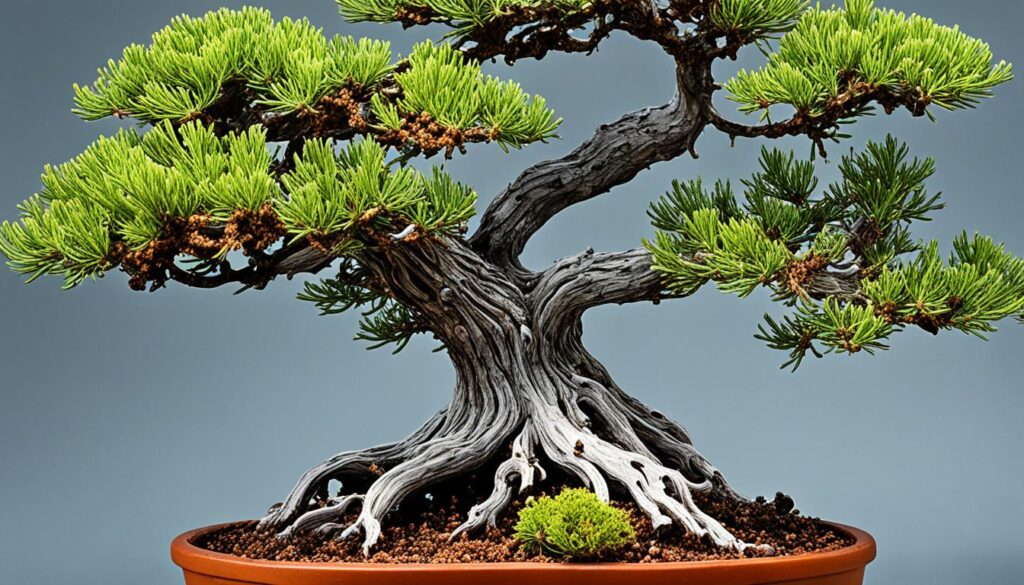Did you know a juniper bonsai tree can live over 100 years with the right care? This ancient art from Japan has won the hearts of gardeners around the world. The juniper is a top pick for those who love bonsai. Learning to grow and keep a juniper bonsai tree is both challenging and rewarding.
Key Takeaways
- Juniper bonsai trees thrive in hardiness zones 3 to 11 (USDA).
- There are 50-70 species of juniper trees and shrubs, with the Chinese juniper being a favorite for bonsai.
- Regular pruning is key for the health and look of juniper bonsai trees.
- Juniper bonsai are easy to grow from cuttings, best done in late spring and summer.
- With proper care, juniper bonsai can do well indoors or outdoors, making them great for bonsai lovers.
Introduction to Bonsai Juniper Trees
The art of bonsai has always been drawn to the juniper tree. Juniper bonsai trees are loved for their simple care and beautiful leaves. They are actually juniper shrubs shaped to look like full-size trees through careful growth and pruning.
What is a Bonsai Juniper Tree?
There are 50-70 species of juniper trees and shrubs, making them diverse evergreens. These trees grow tall and have leaves that look like scales or needles. Bonsai lovers use these traits to create beautiful miniatures that can live indoors or outside.
Benefits of Growing Bonsai Juniper Trees
Bonsai juniper trees are great for hobbyists and gardeners. They can handle different climates and live both inside and outside. Plus, a well-cared-for juniper bonsai tree adds peace and beauty to any room.
“A 20-year-old Juniper bonsai tree with great potential is priced at around $200 USD.”
Juniper bonsai trees have been a favorite in the bonsai world for centuries. With proper care, they can add elegance to any space, indoors or outdoors.
Choosing the Right Juniper Bonsai Variety
When you want to grow a juniper bonsai, you have many options. There are over 70 juniper species for bonsai. You can pick from different shapes, sizes, and colors that fit your style and growing space.
Popular Juniper Bonsai Varieties
Some top juniper bonsai types are:
- Chinese Juniper (Juniperus chinensis), also known as Hollywood juniper, with scale-like leaves and a twisting shape.
- Common Juniper (Juniperus communis), a species with needle leaves found all over the world.
- California Juniper (Juniperus californica), often grown as a shrub and great for drought-tolerant gardens.
Each juniper bonsai type has its own special traits. For example, the Juniperus Procumbens Nana has healthy green leaves, grows compactly, and fits many styles. It’s perfect for beginners.
The Sabina Juniper has a twisted look, great for casual bonsai styles like informal upright or literati. The Rocky Mountain Juniper is from the western U.S. and suits natural styles. It has bluish-green needles that do well in tough conditions.
The Blue Star Juniper comes from the Himalayas and western China. It’s known for its bright blue-green needles and small to medium size. But, it might get spider mites, so watch out for pests.
When picking a juniper bonsai, think about size, shape, foliage, growth, hardiness, and health. Make sure it fits your climate and growing conditions. Different junipers handle the environment differently.

Setting Up Your Bonsai Juniper Tree
Ideal Growing Conditions
Bonsai juniper trees love bright, direct sunlight. They need at least six to eight hours of full sun every day. These trees do well outdoors in temperate climates. It’s important to give your juniper bonsai lots of sunlight for it to grow and thrive.
Potting and Soil Requirements
Bonsai juniper trees need a special soil mix that drains well. This mix usually has akadama, organic potting compost, pumice, and fine gravel or grit. Good drainage stops the soil from getting too wet, which can cause root rot.
It’s a good idea to repot your juniper bonsai every two to three years. Do this in early spring when it’s growing the most. This helps keep the tree healthy and lets the roots spread out in the new soil.
“Ensuring adequate drainage is imperative to prevent the soil from becoming waterlogged and causing root rot in your bonsai juniper tree.”
By giving your bonsai juniper the right growing conditions and soil, you’re setting it up for a long, healthy life. It will bring you joy with its unique beauty and character.
Watering Your Bonsai Juniper Tree
Keeping the right watering schedule is key for your bonsai juniper tree‘s health and life. These trees do well with soil that’s always a bit moist but can’t stand being soaked. Make sure the soil dries a bit between waterings before you give it a good soaking.
There’s no single way to water bonsai juniper trees. The best method is to check the soil often and water when it gets dry. This way, you avoid overwatering, which can harm the tree. The tree’s needs change with the weather and its root health.
- Try to keep the bonsai juniper soil moist, but don’t let it get too wet.
- Let the soil dry a bit before you water it again, then give it a good soaking.
- Check the soil often and water when it feels dry, rather than sticking to a set schedule.
By following these bonsai juniper watering tips, your tree will get the moisture it needs to flourish. Remember, being consistent with watering is crucial for bonsai juniper trees.

“The secret to a healthy bonsai juniper is finding the perfect balance between keeping the soil moist and avoiding waterlogging.”
Feeding and Fertilizing Your Bonsai Juniper
Keeping your bonsai juniper tree healthy means feeding and fertilizing it regularly. Bonsai junipers need nutrients to grow well. The right fertilizer at the right time helps your juniper bonsai stay strong and colorful.
Fertilizer Types and Application
For your bonsai juniper, choose a nitrogen-rich bonsai juniper fertilizer. Junipers love food high in nitrogen. A slow-release organic fertilizer every month during the growing season works great.
For faster growth, use a liquid fertilizer when you water your bonsai juniper. But don’t overdo it, as too much can harm the plant.
Don’t fertilize your bonsai juniper for a month after repotting. This helps the roots heal and keeps the plant from getting stressed.
“Junipers consist of about 50 to 70 different species within the cypress family, and they are one of the most popular forms of bonsai.”
- Use a slow-release organic fertilizer once a month during the growing season.
- Apply a liquid fertilizer every week when watering for a boost in growth.
- Avoid fertilizing for at least a month after repotting to prevent root stress.
By following these tips for fertilizing bonsai juniper, you’ll keep your bonsai healthy and lively. Enjoy your bonsai juniper for years to come.
Pruning and Shaping Your Bonsai Juniper Tree
Proper and regular pruning is key for keeping your bonsai juniper tree looking great and healthy. Pruning junipers needs a gentle touch. It’s better to pinch the branch tips to make the foliage more compact and dense.
Juniper bonsai trees can take a lot of pruning, but remember to keep some foliage on the branches. This helps with growth and health. The best time to prune your bonsai juniper is early spring and summer when it’s growing.
Techniques for Pruning Junipers
When pruning bonsai juniper trees, focus on pinching the growth, not cutting it. Cutting can make the needles die off, hurting the tree’s look and health. Pinch off the tips with your fingers, leaving some foliage on each branch.
Also, shaping bonsai juniper trees means thinning out the foliage. This lets sunlight get through, preventing die-back and keeping the tree healthy and bright. When bonsai juniper pinching, take out any long or stray shoots to keep the tree neat and balanced.

“Proper pruning is essential for the long-term health and aesthetic of your bonsai juniper tree. By focusing on pinching and selective thinning, you can maintain the desired shape and promote vigorous growth.”
It’s a good idea to prune your bonsai juniper two or three times during the growing season. The first pruning should be in early spring. This lets the tree recover and grow a strong secondary flush. Then, you can refine the shape with more pruning later.
Propagating Bonsai Juniper Trees
Starting a bonsai collection often means growing new plants from cuttings. Juniper bonsai cuttings are a great way to do this. Juniper trees are a favorite among bonsai lovers, making up a big part of the growing bonsai market.
Growing Junipers from Cuttings
How well you can grow bonsai juniper propagation depends on your climate. But, taking cuttings is usually the best and easiest way. Juniper cuttings can start to root in just 4-6 weeks. It might take up to 6 months for a strong root system before moving them outside in spring.
To grow junipers from cuttings, pick a healthy branch that’s 0.25 to 0.5-inch thick and 4 to 6 inches long. Cut the base of the branch at a 45-degree angle. Put it 2 inches deep in a pot with moist, well-draining bonsai soil. Keep the soil a bit damp. With the right conditions, your growing juniper bonsai from cuttings will start to grow and flourish.
“Propagating junipers can be done through cuttings, seed, or laying, with cuttings being the easiest and most effective method.”
Growing juniper bonsai from cuttings is the most common method. But, you can also grow them from seed or by layering. Seed starting needs extra care early on, and layering takes years for a branch to develop roots. Yet, cuttings are the top choice for most because they’re simple and work well.
If you’re new to bonsai or want to grow your collection, learning about bonsai juniper propagation is key. With the right techniques and patience, you can grow a beautiful bonsai juniper tree at home.
Repotting Your Bonsai Juniper Tree
Repotting your bonsai juniper tree is key to keeping it healthy. But, these trees don’t need repotting often. Young ones can go two years between repottings, and older ones up to five years.
When it’s time to repot your bonsai juniper, be careful not to cut too many roots. This can harm the plant. Use natural materials like clay or terra-cotta pots to help dry out the soil.
The best time to repot bonsai juniper trees is early spring. This is when they start to wake up from their sleep. It lets the tree recover and grow strong roots before it gets busy growing leaves.
- Carefully remove the bonsai juniper from its current bonsai juniper potting containers.
- Gently tease away any excess soil, taking care not to damage the delicate root structure.
- Prune the roots, if necessary, but avoid removing more than one-third of the total root mass.
- Select a new bonsai juniper potting container that is slightly larger than the previous one, allowing for a few years of growth.
- Fill the new container with a well-draining bonsai soil mix, ensuring the root ball is properly positioned.
- Water the repotted bonsai juniper thoroughly, and monitor it closely in the weeks following to ensure a successful transition.
By following these best practices for repotting bonsai juniper trees, you can ensure your beloved plant continues to thrive and maintain its beautiful, miniaturized form for years to come.
“Repotting is a crucial step in the life of a bonsai tree, allowing it to continue its healthy growth and development.”

Overwintering Your Bonsai Juniper Tree
When the weather gets colder, overwintering bonsai juniper trees is key for gardeners. These tough plants can handle frost, but they still need some extra care to make it through the cold.
Protecting bonsai juniper in winter is vital to keep their roots and leaves safe. Move the bonsai to a spot that’s protected, like a greenhouse, cold frame, or a shaded part of your home. This keeps the bonsai juniper cold weather care safe from strong winds and big temperature changes.
- Wrap the container with burlap, straw, or foam to add more protection against frost.
- Slowly get the bonsai used to the cold before winter starts.
- Check the soil often and water the tree when it’s dry, as dryness can be as bad as too much moisture in winter.
By doing these things, you can help your bonsai juniper tree survive the winter. It will come back strong and ready for new growth in the spring.
“The key to successful overwintering of bonsai junipers is to provide them with the right balance of protection and exposure to the elements. With a little care and attention, these resilient trees can thrive even in the harshest of winter conditions.”
Pest and Disease Management for Bonsai Juniper Trees
Keeping your bonsai juniper tree healthy is key to its success. These trees are tough but can get pests and diseases if not cared for right. Knowing how to spot and fix these problems is vital for your juniper bonsai’s health.
Common Pests and Diseases
The spruce spider mite is a big problem for bonsai juniper trees. These tiny bugs drink the sap, causing needles to turn brown and fall off. To fight a mite infestation, spray the tree with water to wash them away.
Juniper bonsai can also get diseases like blight and rust. These diseases make branches and needles turn brown and fall off. They often come from bad planting spots, like too much shade or poor drainage. You might need to use a fungicide to fight these diseases.
“Proper pest and disease management is essential for maintaining the health and longevity of your bonsai juniper tree.”
By watching your tree closely and acting fast, you can keep your bonsai juniper looking great for many years. Check your tree often, treat problems quickly, and make sure it has the best growing conditions. This will help stop and manage pests and diseases in your bonsai juniper tree.

bonsai juniper tree Styling Techniques
Juniper trees are a favorite among bonsai lovers for their toughness. They can handle harsh pruning well. These trees are often shaped into beautiful root-over-rock styles, thanks to their soft wood that bends easily. When styling a juniper bonsai, it’s best to pinch back new growth. Cutting it back can cause the needles to die.
Wiring is a key technique in shaping juniper bonsai. It helps you shape and place branches as you like. But, make sure to remove the wire once the branch looks good. Leaving it on too long can cause wire marks, or “wire bite.”
It’s also important to thin out the foliage on a juniper bonsai. This means removing unwanted growth like “runts” and “hotheads.” By doing this, you let more light into the tree. This helps the inner and lower branches stay healthy and strong.
- Focus on pinching back new growth rather than cutting it back
- Utilize wiring to shape and position branches, but monitor for wire bite
- Thin out the foliage mass to promote air and light distribution within the tree
- Prune a mix of immature needle foliage and mature scale foliage
Learning to style a juniper bonsai takes time, patience, and an eye for detail. With techniques like wiring, thinning foliage, and selective pruning, you can make beautiful juniper bonsai. These trees show off the beauty of this amazing tree species.
Tips for Caring for Bonsai Juniper Trees Indoors
While indoor juniper bonsai care needs extra attention, these trees can do well indoors with the right setup. The main thing is to give your juniper bonsai lots of bonsai juniper indoor lighting.
Your bonsai juniper should get at least 6-8 hours of direct sunlight each day. Put it near a window that faces south or use a grow light for enough light. In winter, move it to a cooler spot with less light to mimic its dormant season.
- Provide your indoor juniper bonsai with at least 6-8 hours of direct sunlight per day
- Use a south-facing window or grow light to meet the lighting needs
- Move the bonsai to a cooler, low-light area during the winter to allow for dormancy
Watering is key for your juniper bonsai’s health. Let the soil dry out a bit between waters, but don’t let it get too dry. Spraying the leaves with water can also keep humidity right.
“Proper indoor bonsai juniper care is essential for the long-term success of your miniature tree.”
Pruning and shaping your bonsai regularly keeps it looking good and the right size. Always use sharp, clean tools and know how to prune junipers correctly.

Follow these tips for indoor juniper bonsai care, and you’ll love having a bonsai juniper tree at home or work. With the right bonsai juniper tree indoor placement and bonsai juniper indoor lighting, your juniper will flourish and add nature’s beauty to your space.
Conclusion
Juniper bonsai trees are great for both new and skilled bonsai lovers. They are tough, easy to care for, and have beautiful leaves. By following the right steps for placing, watering, feeding, trimming, and keeping them through the winter, you can grow a healthy bonsai juniper tree. This tree will bring you joy and be a beautiful piece of art in your home or garden.
The Juniper bonsai trees talked about here are a flexible and fulfilling choice. They can make your indoor or outdoor areas look better with their classic beauty. With the right methods and hard work, you can make a bonsai juniper that will impress your friends and neighbors.
If you’re starting with bonsai or you’re already an expert, the advice in this article will help you take care of your bonsai juniper tree. These plants bring peace and artistic beauty to your life. Enjoy the process of shaping and caring for your own bonsai masterpiece.


